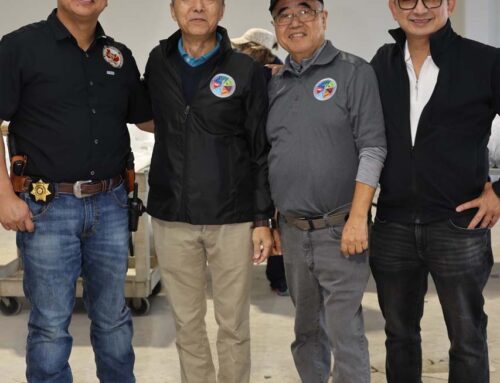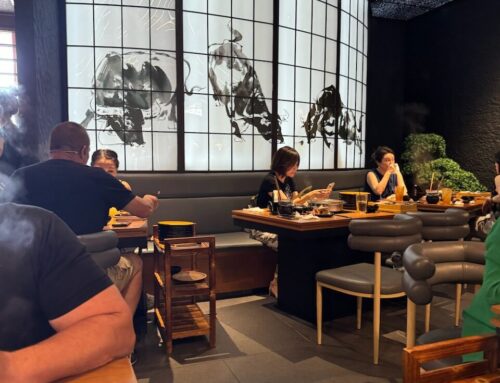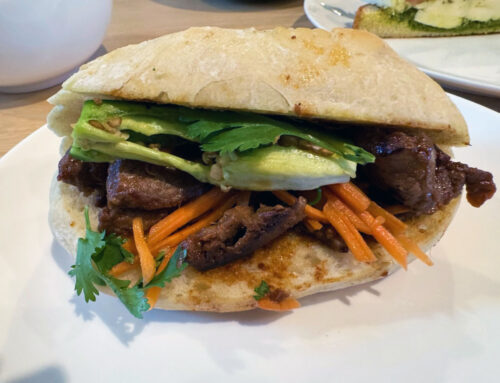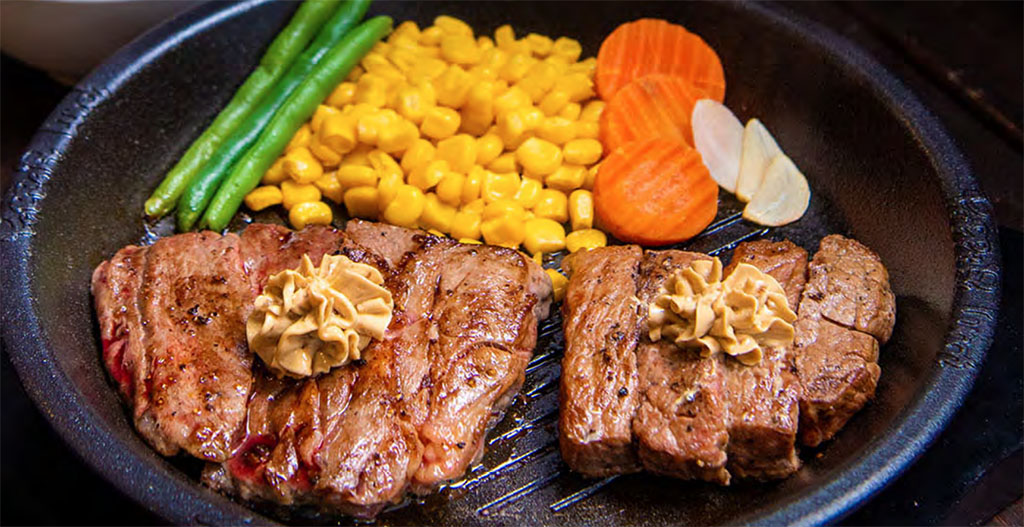
It’s not every lunch chain that confronts you with a spitting-hot iron pan bound by a paper collar that warns: DO NOT TOUCH.
But it’s mealtime as usual at Pepper Lunch, a Japanese DIY steakhouse in the Bellaire Food Street center at 9393 Bellaire Blvd. in the Southwest Management District.
It’s a high concept place: Japanese-style barbecue — normally a festive tabletop meal for group outings — designed to be eaten sizzling hot, in garlic sauce flown in from Tokyo, at lightning speed. Alone.
A Tokyo-based franchise with over four hundred outlets throughout Asia, Pepper Lunch is a 21st Century mix of Asian barbecue tradition and the Western penchant for eating out in solitude.
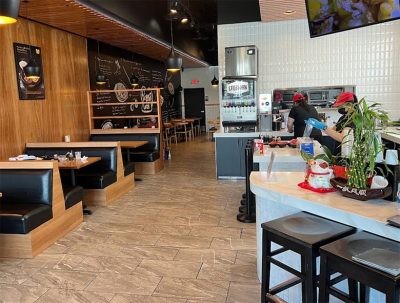 In Japan and Korea, where this style of cooking originated, tabletop barbecue is social food. It’s the kind of meal you have with a bunch of co-workers, or a birthday party, or your sports team.
In Japan and Korea, where this style of cooking originated, tabletop barbecue is social food. It’s the kind of meal you have with a bunch of co-workers, or a birthday party, or your sports team.
At Pepper Lunch, a bit of that festivity remains. Staff members greet you cheerfully before offering to explain the complex menu and preparation process. Once you’ve made your choice and your food arrives, you get to grill it exactly as you please.
In contrast to Japanese tradition, though, Pepper Lunch’s technology, recipes and even the terrifying black skillet are designed with a very particular objective: to get a lone diner fed with a high-quality steak and out the door in less than an hour.
Looked at a certain way, it’s taken centuries for this cuisine to reach Houston. From traditional feasts native to Korea, tabletop barbecue became a mid-20th century big business in Japan. There, a chef-turned-inventor figured out how to make individual grill platters to turn a leisurely communal meal into a one-hour lunch for office workers.
Finally, Pepper Lunch reached the hands of two first-generation Chinese-American entrepreneurs, who bet that Texan barbecue lovers would take to Asian-style beef served with peak efficiency and rugged individualism.
While Pepper Lunch’s aesthetic seems Japanese – minimalist marinades and side dishes, exquisite presentation — in truth the place reflects the hybrid nature of much Japanese cuisine. Specifically, what Japanese know, and adore, as “yakiniku,” sometimes translated as Japanese barbecue, is really a variation on Korean barbecue.
Both styles of restaurant feature a central grill on the table, fueled by coal or gas, where families or bunches of friends cook cuts of beef while they talk and drink. Korean barbecue’s irresistible flavor is based on careful marinades and shared side dishes called banchan; Japanese barbecue, aficionados say, relies more on unembellished ingredients that are accented with sauce after cooking.
During a recent visit shortly before closing, staffers were starting to clean up. Even so, they quickly gathered at the counter, to carefully explain how Pepper Lunch works.
First, you decide on what base you want (rice? pasta?) and which protein (steak? salmon? tofu?). Then you choose your side dishes, condiments and cuts of meat, with the help of a jumbo screen and a photo album showing plate after plate of beautifully composed options.
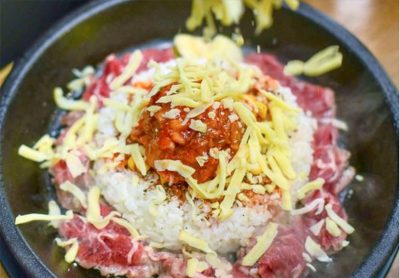 While the album’s mandala-like images are strikingly pretty, the number of choices there can be daunting. The most popular lunch dish, the cashier offers, is the “classic beef:’ steamed rice, tidily capped with corn kernels, encircled with a wreath of finely sliced raw beef primed for grilling.
While the album’s mandala-like images are strikingly pretty, the number of choices there can be daunting. The most popular lunch dish, the cashier offers, is the “classic beef:’ steamed rice, tidily capped with corn kernels, encircled with a wreath of finely sliced raw beef primed for grilling.
As soon as you make your decision, Pepper Lunch’s commitment to harried diners becomes clear. Within five minutes of the cashier’s tutorial, a server is sliding that alarmingly hot skillet, hot oil flecking the air, onto your table.
Beside it, a placard explains what to do next. “Press the rice in the middle,” it instructs, until your rice becomes the perfect shade of golden-crispy. Next, thoroughly mix the ingredients, toss the corn kernels, splash garlic sauce from a flask on the table, and sauté the steak arrayed near the circumference.
Then: taste. The first forkful is shockingly hot — hotter than you’d get in any meal ferried out by a waiter. Calculating the exact moment your food will be cool enough to eat, in fact, adds to the general excitement already created by the friendly staff, the intricate choice process, and the food’s lovely, symmetrical presentation.
And once your meal is safe enough to eat, it’s mouth-watering. The rice is toasty, the corn kernels, refreshing. The garlic-tinged beef is surprisingly spicy. Unlike a lot of speedy lunches eaten alone, the super-efficient Pepper Lunch meal is vivid. It’s an event.
While high quality ingredients — along with thin-cut beef, soy sauce and attention to beauty – are part of Japanese tradition, other culinary details at Pepper Lunch are definitely less so.
In particular, Japanese restaurants of the past didn’t emphasize customization or variety, Japanese cuisine expert Elizabeth Andoh said. Traditionally, Japanese value expertise and reliability over originality in restaurants. “The assumption is that the person who is preparing the food is the expert,” she says. “If there is attention to making a meal individually, that is very American.”
But this is in the process of changing. Like other industrialized countries, Japan is powered by workers who often can squeeze in only a quick bite before rushing back to computer screen or factory. Pepper Lunch’s founder, a chef and inventor, resolved to create a high-quality steak lunch that an office worker could eat without getting yelled at for being tardy. In 1994, he perfected Pepper Lunch’s signature high-temperature skillet, added a customized menu and training for super-efficient staffers.
His biggest innovation, though, may not have been speed but sociology. In Japan, barbecue restaurants are so closely linked to communal, often male, bonding that in recent years some restaurants have made headlines simply for offering an alternative. “Barbecue Solo Without Being Judged!” one article pronounced. “Is it possible to eat grilled beef alone?” another queried. In Tokyo, one restaurant designated certain days of the week for women to venture in and eat barbecue solo.
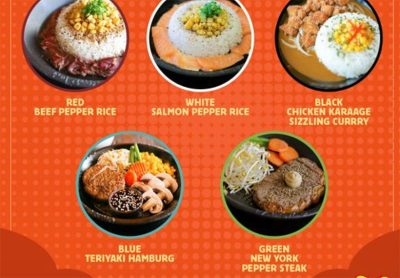 In Houston, of course, diners are used to eating barbecue — as well as personal pizzas, burgers, Japanese food and pretty much anything else — alone. In fact, it’s close to being the American default: a 2105 study by the Food Market Institute, a trade association, found that Americans eat close to 50 percent of our meals and snacks alone — oftentimes in our cars.
In Houston, of course, diners are used to eating barbecue — as well as personal pizzas, burgers, Japanese food and pretty much anything else — alone. In fact, it’s close to being the American default: a 2105 study by the Food Market Institute, a trade association, found that Americans eat close to 50 percent of our meals and snacks alone — oftentimes in our cars.
Even so, a lot of intention goes into making Pepper Lunch’s quick meals memorable, said 35-year-old Nancy Leong, the restaurant’s co-owner. Over that rice in its wreath of steak strips, Pepper Lunch layers a special pepper paste, basically garlic butter. When the crackling skillet is slid in front of the diner, servers carefully place two small flasks of proprietary sauces, one sweet, one garlicky, designed to elevate the flavor still more. Except for the meat, she said, every ingredient in a Pepper Lunch meal is flown in from Japan.
“Even I don’t know what’s in the garlic butter,” she confessed. “We have no idea.”
Leong, her brother and husband started their franchise in 2019 after her brother returned from a trip to Hong Kong smitten with the fast-food steak joint he’d found. Leong already had a fulltime job as a dental worker. But so enthusiastic was her brother about Pepper Lunch that he persuaded Nancy and her husband to sign on as co-owners. When they opened, it was only the third Pepper Lunch in the United States after Las Vegas and Los Angeles.
Only a few months after the doors opened, the pandemic struck. Lockdown was brutal. For a restaurant that relies entirely on cuisine cooked in hot, heavy skillets by the customer, carry-out was particularly depressing.
Struggling, the Leongs laid off their staff, promising to let them know when business returned, and ran the restaurant themselves, sometimes spending hours alone, waiting for an order. They changed the inventory, found cheaper carry-out boxes, and took over the serving jobs without a salary until they could afford to start bringing back some of the staff.
For over a year, like so many of their restaurant peers, they limped by on to-go orders, truncated menus and financial loss. They’re still struggling, Leong said. But diners are now coming in again — and not just at lunchtime — for the full Pepper Lunch experience.
And, Leong said, the siblings learned endurance from having watched their parents back home in California. After moving from China, the elder Leongs worked for decades in Chinese restaurants until they finally earned enough to start their own.
“We didn’t ask or help or advice, and they didn’t offer it,” Leong said. “But I remember my dad working three jobs, day and night, just to keep the family going and have enough savings. They did it from nothing, honestly. I think we learned their mentality: the drive to push through. There is a Chinese saying that no matter how your boat floats, when you get to the dock, it’ll straighten out. So I have that mentality that things will work out.”





